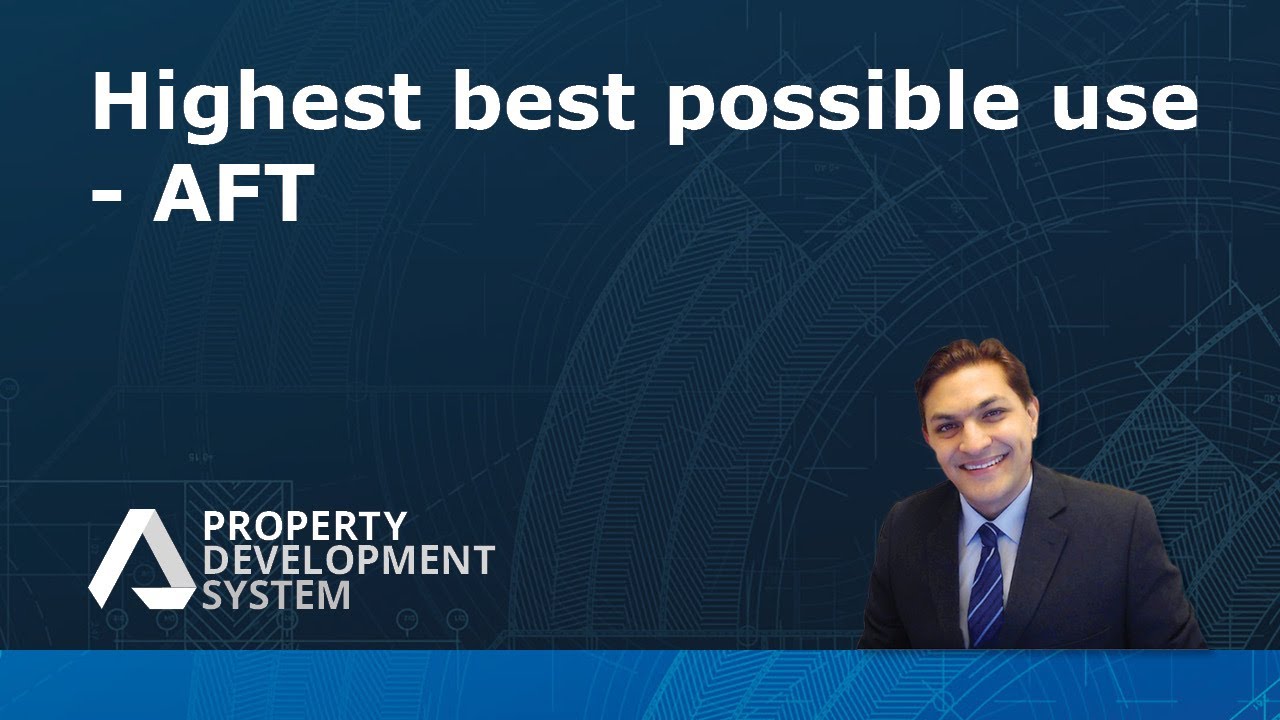Highest Best Possible Use - AFT
Here are the principles and applications of financial feasibility in real estate development, focusing on identifying the highest and best possible use of land. Key insights include:
Financial Feasibility
Described as a crucial tool for real estate projects, financial feasibility studies, development appraisals, or pro formas help in gathering cost and end-value data of a project to assess its viability.
Land Value Determination
The video emphasises the importance of determining the land’s value by considering zoning, planning controls, potential construction height, and additional salable resources on the land (like rocks or trees) to establish the land’s highest and best use.
Market Knowledge
It underscores the significance of understanding the market to accurately predict the selling price of the developed property. This insight helps in making informed decisions regarding the purchase price of the land.
Cost Estimation
Accurate cost estimation is crucial. Knowing the exact costs for development enables a developer to build more cost-effectively than competitors.
Competition Analysis
The presenter outlines four reasons competitors might pay more for the same land: superior knowledge of the land’s potential, better market understanding, accurate cost control, or unrealistic expectations about future market values.
Insights based on numbers
The discussion revolves around the critical analysis and application of numbers in real estate feasibility studies, including the careful consideration of costs, potential revenue, and the comparative value of land based on permissible development parameters.
Frequently Asked Questions
How accurate cost estimation is important in development projects?
Accurate Cost Estimation
It’s emphasised that having precise estimates for the construction and development costs is vital. The ability to forecast these expenses accurately allows developers to create a viable financial plan and ensures the project’s feasibility.
Impact on Competitiveness
Accurate cost control gives developers a competitive edge. By understanding the true costs, a developer might be able to undertake projects more economically than competitors, either by negotiating better prices or by optimising the development plan to reduce expenses without compromising quality.
Risk Mitigation
Precise cost estimation also serves as a risk mitigation tool. It prevents budget overruns and ensures that the project remains within financial boundaries, protecting the investment from unforeseen expenses that could jeopardise the project’s return on investment (ROI).
Influences Feasibility Studies
The presenter points out that cost estimation is a cornerstone of financial feasibility studies. These studies assess whether a project is viable by comparing the total costs against the expected revenue. Accurate cost estimation thus directly influences the decision to proceed with a development project.
What is financial feasibility in real estate development?
Financial feasibility in real estate development is a comprehensive analysis used to evaluate the viability of a project. It involves collecting data on the costs associated with developing a project and the potential end-value or revenue the project could generate. This study helps developers understand whether a project is financially viable and worth pursuing.
How is the value of land determined for its highest and best use?
The value of land is determined by evaluating several key factors including zoning laws, planning controls, the potential for construction height, and any additional resources that can be sold, such as rocks or trees. By considering these elements, developers can establish what the highest and best use of the land is, maximizing its value and potential profitability.
Why is market knowledge important in real estate development?
Market knowledge is crucial in real estate development because it enables developers to accurately predict the selling price of the developed property. This understanding helps in making informed decisions about the purchase price of the land, ensuring that the development is both competitive in the market and financially viable.
What are the reasons competitors might pay more for the same land?
Competitors might pay more for the same piece of land due to several factors: they may have superior knowledge of the land’s development potential, a better understanding of market conditions, more accurate control over development costs, or they might have unrealistic expectations about future market values. These factors can influence their willingness to invest more in a property.
How are numbers used in the analysis of real estate feasibility studies?
Numbers play a critical role in real estate feasibility studies as they provide a quantitative basis for evaluating the potential costs, revenue, and comparative value of land based on its development parameters. Through careful consideration of these numbers, developers can make informed decisions about the financial viability of projects, weighing the investment against the potential return.
Test Your Knowledge
Multiple-Choice Questions on Highest Best Possible Use in Real Estate Development
1. What is the primary purpose of conducting financial feasibility studies in real estate development?
A) To fulfil regulatory requirements.
B) To assess the environmental impact of the project.
C) To evaluate the financial viability of a project by gathering cost and end-value data.
D) To select the architectural style of the development.
2. When determining the land’s highest and best use, which of the following factors should be considered?
A) The colour of the soil.
B) Zoning, planning controls, potential construction height, and additional salable resources.
C) The historical significance of the land.
D) The preference of the developer.
3. Why is market knowledge crucial in real estate development?
A) It helps in avoiding legal issues.
B) It is important for branding purposes.
C) It enables developers to accurately predict the selling price of the developed property.
D) Construction permits are required.
4. Accurate cost estimation in real estate development is crucial because it:
A) Guarantees a profit margin.
B) Allows for unlimited budgeting.
C) Enables a developer to build more cost-effectively than competitors.
D) Ensures the project will be completed on time.
5. Which of the following reasons might lead competitors to pay more for the same piece of land?
A) A desire to hold the land without developing it.
B) Superior knowledge of the land’s potential, better market understanding, accurate cost control, or unrealistic expectations about future market values.
C) Personal preference for the location.
D) Government incentives.
6. In real estate feasibility studies, the critical analysis and application of numbers involve:
A) Estimating the number of potential residents.
B) Calculating the distance to the nearest city.
C) Careful consideration of costs, potential revenue, and the comparative value of land based on permissible development parameters.
D) Predicting future zoning laws changes.
Answers
- C) To evaluate the financial viability of a project by gathering cost and end-value data.
- B) Zoning, planning controls, potential construction height, and additional salable resources.
- C) It enables developers to accurately predict the selling price of the developed property.
- C) Enables a developer to build more cost-effectively than competitors.
- B) Superior knowledge of the land’s potential, better market understanding, accurate cost control, or unrealistic expectations about future market values.
- C) Careful consideration of costs, potential revenue, and the comparative value of land based on permissible development parameters.
Assignment
Application of Highest Best Possible Use Principles in Real Estate Development
Objectives
- Apply the principles of financial feasibility to a real estate project.
- Determine the highest and best use of a specified parcel of land.
- Utilise market knowledge to inform development decisions.
- Estimate costs associated with potential development.
- Analyse competition to better position the development project.
Instructions
Selection of a Land Parcel
Identify a parcel of land in your community or any fictional area that you believe has potential for development. Provide a brief description of the land, including its size, location, and current use.
Research
Conduct research to gather information on zoning, planning controls, and any restrictions that may impact potential development on the selected land parcel.
Land Value Determination
Evaluate the selected land parcel to identify its highest and best use. Consider factors such as zoning, potential construction height, and additional salable resources (e.g., minerals, trees). Explain your reasoning.
Market Analysis
Perform a market analysis to understand the potential demand for the developed property. Identify key factors that would influence the selling price of the developed property. Consider the current market trends, comparable sales, and future market projections in your analysis.
Cost Estimation
Estimate the development costs for your proposed project. This should include land acquisition costs, construction costs, legal and regulatory fees, and any other relevant expenses. Detail how you arrived at these estimates.
Competition Analysis
Identify potential competitors for your development project. Analyze their strengths and weaknesses, and explain how your project can be positioned to compete effectively. Consider factors such as superior knowledge of the land’s potential, better market understanding, and more accurate cost control.
Feasibility Study
Based on the information gathered and the analyses conducted, prepare a simplified financial feasibility study for your proposed development. Include projected revenues, development costs, and a preliminary assessment of the financial viability of the project.
Report
Compile your findings and analyses into a comprehensive report. Your report should include an introduction to the project, methodologies used for research and analysis, results of your analyses, and your conclusions on the financial viability and potential success of the development project.
Deliverables
- A detailed report containing all sections outlined in the instructions.
- Appendices with supporting documents, research data, and any other materials used in your analyses.



